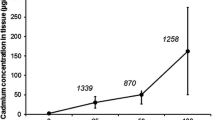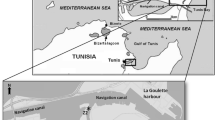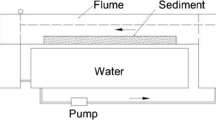Abstract
To assess the toxicity and accumulation (total and subcellular partitioning) of cadmium (Cd) and mercury (Hg), juvenile eastern oysters, Crassostrea virginica, were exposed for 4 weeks to a range of concentrations (Control, Low (1×), and High (4×)). Despite the 4-fold increase in metal concentrations, oysters from the High-Cd treatment (2.4 μM Cd) attained a body burden that was only 2.4-fold greater than that of the Low-Cd treatment (0.6 μM Cd), while oysters from the High-Hg treatment (0.056 μM Hg) accumulated 8.9-fold more Hg than those from the Low-Hg treatment (0.014 μM Hg). This fold difference in total Cd burdens was, in general, mirrored at the subcellular level, though binding to heat-denatured proteins in the High-Cd treatment was depressed (only 1.6-fold higher than the Low-Cd treatment). Mercury did not appear to appreciably partition to the subcellular fractions examined in this study, with the fold difference in accumulation between the Low- and High-Hg treatments ranging from 1.5-fold (heat-stable proteins) to 4.6-fold (organelles). Differences in toxicological impairments (reductions in condition index, protein content, and ETS activity) exhibited by oysters from the High-Cd treatment may be partially due to the nature of how different metals partition to subcellular components in the oysters, though exact mechanisms will require further examination.




Similar content being viewed by others
References
Amaird JC, Amiard-Triquet C, Barka S, Pellerin J, Rainbow PS (2006) Metallothioneins in aquatic invertebrates: their role in metal detoxification and their use as biomarkers. Aquat Toxicol 76:160–202
Anandraj A, Marshall DJ, Gregory MA, McClurg TP (2002) Metal accumulation, filtration, and O2 uptake rates in the mussel Perna perna (Mollusca: Bivalvia) exposed to Hg2+, Cu2+, and Zn2+. Comp Biochem Physiol C 132:355–363
Balcom P, Hammerschmidt CR, Fitzgerald WF, Lamborg CH, O’Connor JS (2008) Seasonal distributions and cycling of mercury and methylmercury in the waters of New York/New Jersey Harbor Estuary. Mar Chem 109:1–17
Bartlett JK, Maher WA, Purss MBJ (2018) Cellular energy allocation analysis of multiple marine bivalves using near infrared spectroscopy. Ecol Indic 90:247–256
Bopp RF, Chillrud SN, Shuster EL, Simpson HJ. 2006. Contaminant chronologies from the Hudson River sedimentary records. In: Levinton JS, Waldman JR (Eds). The Hudson River Estuary. Cambridge University Press, New York. Pp. 383-397.
Brown CL, Luoma SN (1995) Use of the euryhaline bivalve Potamocorbula amurensis as a biosentinel species to assess trace metal contamination in San Francisco Bay. Mar Ecol Prog Ser 124:129–142
Cain DJ, Luoma SN, Wallace WG (2004) Linking metal bioaccumulation of aquatic insects to their distribution patterns in a mining-impacted river. Environ Toxicol Chem 23:1463–1473
Cherkasov AS, Grewal S, Sokolova IM (2007) Combined effects of temperature and cadmium exposure on hemocyte apoptosis and cadmium accumulation in the eastern oyster Crassostrea virginica (Gmelin). J Therm Biol 32:162–170
Cherkasov AS, Taylor C, Sokolova IM (2009) Seasonal variation in mitochondrial responses to cadmium and temperature in eastern oysters Crassostrea virginica (Gmelin) from different latitudes. Aquat Toxicol 97:68–78
Chu FLE, Volety AK, Hale RC, Huang Y (2002) Cellular responses and disease expression in oysters (Crassostrea virginica) exposed to suspended field—contaminated sediments. Mar Environ Res 53:17–35
Cooper S, Hare L, Campbell PGC (2010) Subcellular partitioning of cadmium in the freshwater bivalve, Pyganodon grandis, after separate short-term exposures to waterborne or diet-borne metal. Aquat Toxicol 100:303–312
Crosby MP, Gale LD (1990) A review and evaluation of bivalve condition index methodologies with a suggested standard method. J Shellfish Res 9:233–237
Cunningham P (1976) Inhibition of shell growth in the presence of mercury and subsequent recovery of juvenile oysters. Proc Natl Shellfish Assoc 66:1–5
Engel DW (1999) Accumulation and cytosolic partitioning of metals in the American oyster Crassostrea virginica. Mar Environ Res 47:89–102
Erk M, Muyssen BTA, Ghekiere A, Janssen C (2008) Metallothionein and cellular energy allocation in the estuarine mysid shrimp Neomysis integer exposed to cadmium at different salinities. J Exp Mar Biol Ecol 357:172–180
Franz DR (1982) A historical perspective on mollusks in lower New York Harbor, with emphasis on oysters. In: Mayer GF (ed) Ecological stress and the New York Bight: science and management. Estuarine Research Foundation, Columbia, pp 181–197
Gagnaire B, Thomas-Guyon H, Renault T (2004) In vitro effects of cadmium and mercury on Pacific oyster, Crassostrea gigas (Thunberg), hemocytes. Fish Shellfish Immun 16:501–512
García-Esquivel Z, Bricelj VM, González-Gómez MA (2001) Physiological basis for energy demands and early post-larval mortality in the Pacific oyster, Crassostrea gigas. J Exp Mar Biol Ecol 263:77–103
Geffard A, Geffard O, His E, Amiard JC (2002) Relationships between metal bioaccumulation and metallothionein levels in larvae of Mytilus galloprovincialis exposed to contaminated estuarine sediment elutriate. Mar Ecol Prog Ser 233:131–142
Gėret F, Jouan A, Turpin V, Bebianno MJ, Cosson RP (2002) Influence of metal exposure on metallothionein synthesis and lipid peroxidation in two bivalve mollusks: the oyster (Crassostrea gigas) and the mussel (Mytilus edulis). Aq Living Resour 15:61–66
Gnaiger E, Bitterlich G (1984) Proximate biochemical composition and caloric content calculated from elemental CHN analysis: a stoichiometric concept. Oecologica 62:289–298
Goto D, Wallace WG (2007) Interaction of Cd and Zn during uptake and loss in the polychaetes Capitella capitata: whole body and subcellular perspectives. J Exp Mar Biol Ecol 352:65–77
Goto D, Wallace WG (2009) Biodiversity loss in benthic macroinfaunal communities and its consequence for organic mercury trophic availability to benthivorous predators in the lower Hudson River estuary, USA. Mar Pollut Bull 58:1909–1915
Gregory MA, Marshall DJ, George RC, Anandraj A, McClurg TP (2002) Correlations between metal uptake in the soft tissue of Perna perna and gill filament pathology after exposure to mercury. Mar Pollut Bull 45:114–125
Guo L, Santschi PH, Ray S (2002) Metal partitioning between dissolved and particulate phases and its relation with bioavailability to American oysters. Mar Environ Res 54:49–64
Hatch WR, Ott WL (1968) Determination of sub-microgram quantities of mercury by atomic absorption spectrophotometry. Anal Chem 40:2085–2087
Ivanina AV, Taylor C, Sokolova IM (2009) Effects of elevated temperature and cadmium exposure on stress protein response in eastern oysters Crassostrea virginica (Gmelin). Aquat Toxicol 91:245–254
Ivanina AV, Sokolov EP, Sokolova IM (2010) Effects of cadmium on anaerobic energy metabolism and mRNA expression during air exposure and recovery of an intertidal mollusk Crassostrea virginica. Aquat Toxicol 99:330–342
Ivanina AV, Froelich B, Williams T, Sokolov EP, Oliver JD, Sokolova IM (2011) Interactive effects of cadmium and hypoxia on metabolic responses and bacterial loads of eastern oysters Crassostrea virginica Gmelin. Chemosphere 82:377–389
Kawaguchi T, Porter D, Bushek D, Jones B (1999) Mercury in the American oyster Crassostrea virginica in South Carolina, U.S.A., and public health concerns. Mar Pollut Bull 38:324–327
Klajović-Gašpić Z, Odžak N, Ujević I, Zvonarić T, Horvat M, Barić A (2006) Biomonitoring of mercury in polluted coastal areas using transplanted mussels. Sci Total Environ 368:199–209
Lannig G, Flores JF, Sokolova IM (2006) Temperature-dependent stress response in oysters, Crassostrea virginica: pollution reduces temperature tolerance in oysters. Aquat Toxicol 79:278–287
Levinton JS, Waldman JR (2006) In: Levinton JS, Waldman JR (eds) The Hudson River EstuaryThe Hudson River Estuary: executive summary. Cambridge University Press, New York, pp 1–13
Levinton JS, Doall M, Ralston D, Starke A, Allam B (2011) Climate change, precipitation and impacts on an estuarine refuge from disease. PLoS One 6:E18849
Lim PE, Lee CK, Din Z (1998) The kinetics of bioaccumulation of zinc copper, lead and cadmium by oysters (Crassostrea iredalei and C. belcheri) under tropical field conditions. Sci Total Environ 216:147–157
Macey BM, Jenny MJ, Williams HR, Thibodeaux LK, Beal M, Almeida JS, Cunningham C, Mancia A, Warr GW, Burge EJ, Holland AF, Gross PS, Hikima S, Burnett KG, Burnett L, Chapman RW (2010) Modeling interactions of acid-base balance and respiratory status in the toxicity of metal mixtures in the American oyster Crassostrea virginica. Comp Biochem Phys A 155:341–349
Macías-Mayorga D, Laiz I, Moreno-Garrido I, Blasco J (2015) Is oxidative stress related to cadmium accumulation in the Mollusc Crassostrea angulata? Aquat Toxicol 161:231–241
Madon SP, Schneider DW, Stoeckel JA (1998) In-situ estimation of zebra mussel metabolic rates using the electron transport system (ETS) assay. J Shellfish Res 17:195–203
Markich SJ, Brown PL, Jeffree RA (2001) Divalent metal accumulation in freshwater bivalves: an inverse relationship with metal phosphate solubility. Sci Total Environ 275:27–41
Mass Fitzgerald A (2013) The effects of chronic habitat degradation on the physiology and metal accumulation of eastern oysters, Crassostrea virginica. Doctoral Dissertation. The Graduate Center, City University of New York
Meng J, Wang W, Li L, Yin Q, Zhang G (2017) Cadmium effects on DNA and protein metabolism in oyster (Crassostrea gigas) revealed by proteomic analyses. Sci Rep 7:11716
Mouneyrac C, Amiard JC, Amiard-Triquet C (1998) Effects of natural factors (salinity and body weight) on cadmium, copper, zinc, and metallothionein-like protein levels in resident populations of oysters Crassostrea gigas from a polluted estuary. Mar Ecol Prog Ser 162:125–135
Mubiana VK, Vercauteren K, Blust R (2006) The influence of body size, condition index and tidal exposure on the variability in metal bioaccumulation in Mytilus edulis. Environ Pollut 144:272–279
Ng TY-T, Chuang C-Y, Stupakoff I, Christy AE, Cheney DP, Wang W-X (2010) Cadmium accumulation and loss in the Pacific oyster Crassostrea gigas along the west coast of the USA. Mar Ecol Prog Ser 400:147–160
NYSDEC (2003) Contaminant Assessment and Reduction Project: NY/NJ Harbor Sediment Report 1998–2001. http://www.hudsonriver.org/CARP/Appendicies/A-1/NYNJ%20Harbor%20Sediment%20Report%20(NYSDEC).pdf. Accessed May 2019
O’Connor TP (2002) National distribution of chemical concentrations in mussels and oysters in the USA. Mar Environ Res 53:117–143
Oliver LM, Fisher WS, Volety AK, Malaeb Z (2003) Greater hemocytes bactericidal activity in oysters (Crassostrea virginica) from a relatively contaminated site in Pensacola Bay, Florida. Aquat Toxicol 64:363–373
Pan K, Wang WX (2011) Mercury accumulation in marine bivalves: influence of biodynamics and feeding niche. Environ Pollut 159:2500–2506
Perceval O, Couillard Y, Pinel-Alloul B, Campbell PGC (2006) Linking changes in subcellular cadmium distribution to growth and mortality rates in transplanted freshwater bivalves (Pyganodon grandis). Aquat Toxicol 79:87–98
Ringwood AH, Conners DE, Hoguet J (1998) Effects of natural and anthropogenic stressors on lysosomal destabilization in oysters Crassostrea virginica. Mar Ecol Prog Ser 166:163–171
Ringwood AH, Conners DE, Keppler CJ (1999) Cellular responses of oysters, Crassostrea virginica, to metal-contaminated sediments. Mar Environ Res 48:427–437
Ringwood AH, Hoguet J, Keppler C, Gielazyn M (2004) Linkages between cellular biomarker responses and reproductive success in oysters Crassostrea virginica. Mar Environ Res 58:151–155
Roesijadi G (1996) Environmental factors: response to metals. In: Kennedy VS, Newell RIE, Eble AF (eds) The eastern oyster, Crassostrea virginica. Maryland Sea Grant College, College Park, pp 515–538
Roesijadi G, Klerks PL (1989) Kinetic analysis of cadmium binding to metallothionein and other intracellular ligands in oyster gills. J Exp Zool 251:1–12
Roesijadi G, Robinson WE (1994) In: Malins DC, Ostrander GK (eds) Aquatic toxicologyMetal regulation in aquatic animals: mechanisms of uptake, accumulation, and release. Lewis Publishers, Boca Raton, pp 387–420
Sanni B, Williams K, Sokolov EP, Sokolova IM (2008) Effects of acclimation temperature and cadmium exposure on mitochondrial aconitase and LON protease from a model marine ectotherm, Crassostrea virginica. Comp Biochem Physiol C 147:101–112
Serra R, Carpenė E, Marcantonio AC, Isani G (1995) Cadmium accumulation and Cd-binding proteins in the bivalve Scapharca inaequivalvis. Comp Biochem Physiol C 111:165–174
Shulkin VM, Presley BJ, Kavun VI (2003) Metal concentrations in mussel Crenomytilus grayanus and oyster Crassostrea gigas in relation to contamination of ambient sediments. Environ Int 29:493–502
Sokolova IM (2004) Cadmium effects on mitochondrial function are enhanced by elevated temperatures in a marine poikilotherm, Crassostrea virginica Gmelin (Bivalvia: Ostreidae). J Exp Biol 207:2639–2648
Sokolova IM, Ringwood AH, Johnson C (2005) Tissue-specific accumulation of cadmium in subcellular compartments of eastern oysters Crassostrea virginica Gmelin (Bivalvia: Ostreidae). Aquat Toxicol 74:218–228
Starke A, Levinton JS, Doall M (2011) Restoration of Crassostrea virginica (Gmelin) to the Hudson River, USA: a spatiotemporal modeling approach. J Shellfish Res 30:671–684
United States Environmental Protection Agency (US EPA) (1999) National recommended water quality criteria – correction. EPA-922-Z-99-001
United States Environmental Protection Agency (US EPA) (2001) 2001 update of ambient water criteria for cadmium. EPA-822-R-01-001
Velez C, Figueira E, Soares AMVM, Freitas R (2016) Accumulation and sub-cellular partitioning of metals and As in the clam Venerupis corrugata: different strategies towards different elements. Chemosphere. 156:128–134
Volety AK (2008) Effects of salinity, heavy metals and pesticides on health and physiology of oysters in the Caloosahatchee Estuary, Florida. Ecotoxicol 17:579–590
Wallace WG, Lee BG, Luoma SN (2003) Subcellular compartmentalization of Cd and Zn in two bivalves. I. Significance of metal-sensitive fractions (MSF) and biologically detoxified metal (BDM). Mar Ecol Prog Ser 249:183–197
Zar JH (1999) Biostatistical analysis, 4th edn. Upper Saddle River, NJ
Zarnoch CB, Schreibman MP (2012) Growth and reproduction of eastern oysters, Crassostrea virginica. Estuary: Implications for restoration, New York City Urban Habitats, 7
Zarnoch CB, Sclafani M (2010) Overwinter mortality and spring growth in selected and non-selected juvenile Mercenaria mercenaria. Aquat Biol 11:53–63
Zhang Y, Song J, Yuan H, Xu Y, He Z, Duan L (2010) Biomarker responses in the bivalve (Chlamys farreri) to exposure of the environmentally relevant concentrations of lead, mercury, copper. Environ Toxicol Pharmacol 30:19–25
Zhong H, Kraemer L, Evans D (2013) Influence of body size on Cu bioaccumulation in zebra mussels Dreissena polymorpha exposed to difference sources of particle-associated Cu. J Hazard Mater 261:746–752
zu Ermgassen PSE, Spalding MD, Grizzle RE, Brumbaugh RD (2013) Quantifying the loss of a marine ecosystem service: filtration by the eastern oyster in US estuaries. Estuar Coasts 36:36–43
Acknowledgments
We thank P. Pieluszynski, K. Lam, and C. Bruno for assistance with laboratory analysis. This manuscript benefitted greatly from edits by D. Seebaugh and two anonymous reviewers. This manuscript is submitted in memory of Dennis Suszkowski, Ph.D., (Science Director of the Hudson River Foundation), whose commitment and dedication to protecting and restoring the Hudson River Estuary will surely resonate for years to come.
Funding
This research was funded by grants from the Hudson River Foundation (AMF; #GF/02/01), PSC-CUNY (WGW, #64524-0042; and CBZ, #62925-0040), The Sounds Conservancy (AMF), and the National Science Foundation (CBZ; #DEB-0918952 and #MRI-0959876). CBZ was also supported by a Eugene Lang Junior Faculty Fellowship.
Author information
Authors and Affiliations
Corresponding author
Additional information
Responsible editor: Cinta Porte
Publisher’s note
Springer Nature remains neutral with regard to jurisdictional claims in published maps and institutional affiliations.
Rights and permissions
About this article
Cite this article
Mass Fitzgerald, A., Zarnoch, C.B. & Wallace, W.G. Examining the relationship between metal exposure (Cd and Hg), subcellular accumulation, and physiology of juvenile Crassostrea virginica. Environ Sci Pollut Res 26, 25958–25968 (2019). https://doi.org/10.1007/s11356-019-05860-1
Received:
Accepted:
Published:
Issue Date:
DOI: https://doi.org/10.1007/s11356-019-05860-1




